Packed with spicy, pungent, and sour flavors, this classic Korean kimchi fried rice recipe can be served as a side or as a main, topped with a fried egg or spam. Ready in 20 minutes from start to finish.
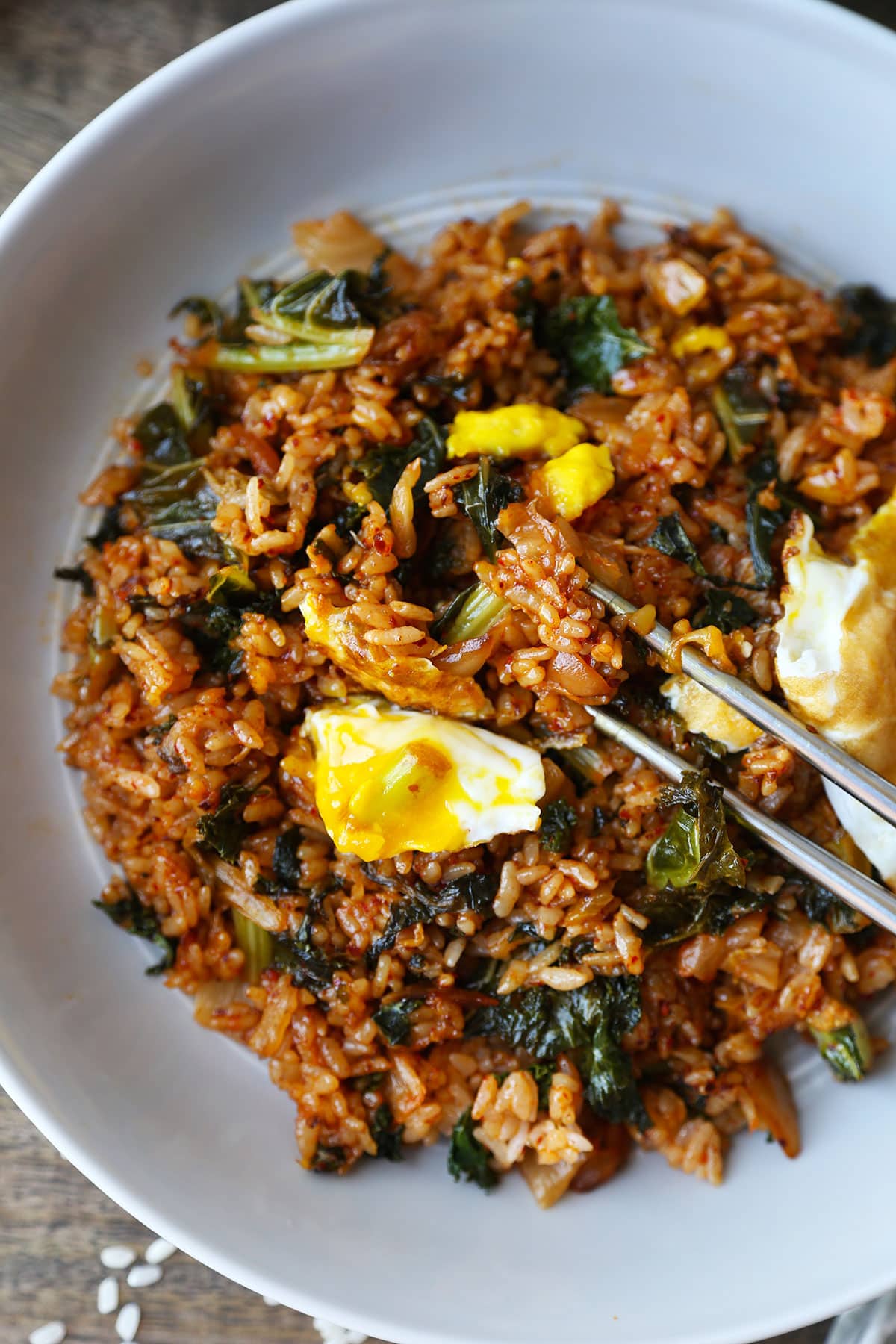
Why this Recipe Works
- There is little prepping involved (less than 10 minutes).
- It can be made ahead of time and keeps well in the fridge.
- It’s versatile. Different proteins, vegetables, and toppings can be used to customize this recipe and make it your own.
Table of contents
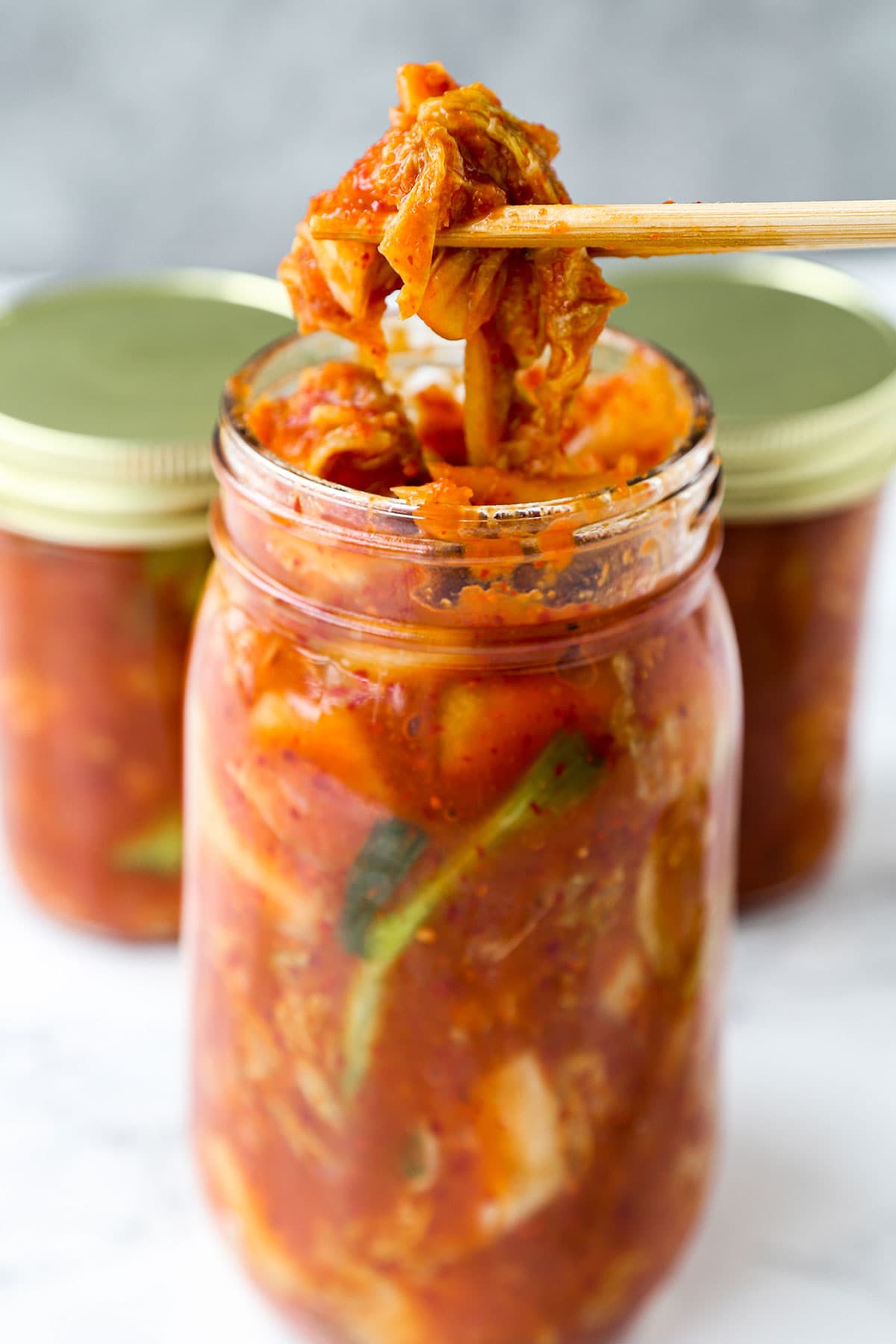
What is Kimchi Fried Rice?
Kimchi fried, or kimchi bokkeumbap (김치 볶음밥), is a popular Korean dish made of leftover rice pan fried with kimchi, and a mixture of soy sauce, gochujang (Korean chili paste) or gochugaru (Korean pepper flakes), and sometimes rice vinegar and/or sesame oil. Vegetables or meats, such as pork belly, are also added from time to time.
For this kimchi fried rice recipe, I’ve added chopped spinach and topped it with a cooked egg to add creaminess. Both ingredients are optional so feel free to leave them out if you don’t have them or simply don’t like them.
Best Rice to Use for Kimchi Fried Rice
Short grain Japanese rice is the best type of rice to use for this recipe because of its sticky and chewy texture.
While medium and long grain rice result in a fried rice that’s more dry and fluffy, short grain rice has a lovely thick and clumpy texture similar to a risotto. Instead of turning mushy, short grain rice becomes chewy and puffy when it absorbs liquid.
It should be noted that most Japanese rice sold in US grocery stores are the medium grain type, so make sure to read the label before buying it. You can find Japanese short grain rice in Japanese supermarket or you can order it online.
My favorite brand is Tamanishiki.
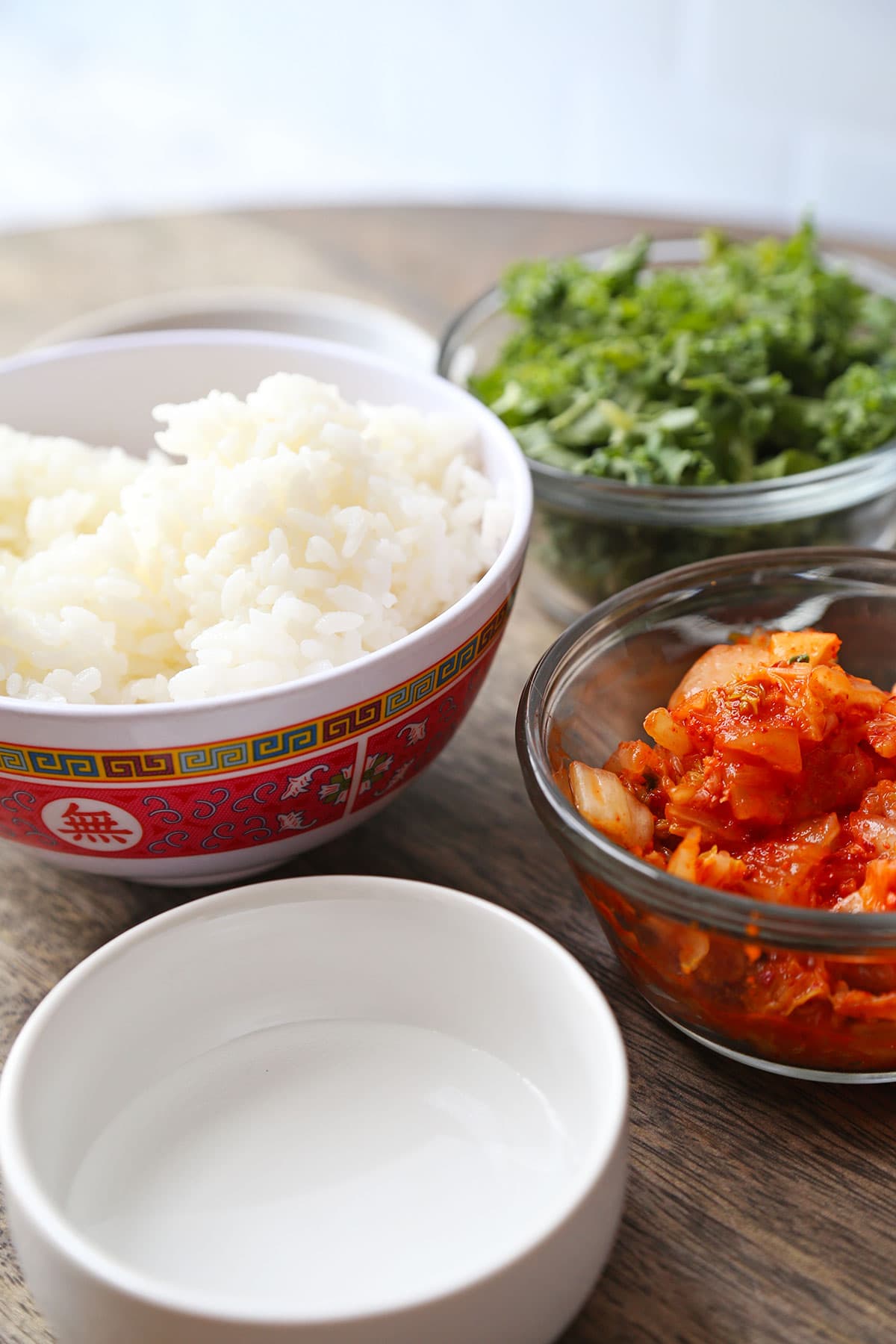
Kimchi Fried Rice Ingredients
- Oil: A little oil is needed to prevent the rice from sticking to the pan. It also gives the rice a slightly crispy texture.
- Kimchi: Kimchi is packed with pungent and spicy flavors and is at the heart of Korean cooking. Make sure to purchase a good kimchi, one you enjoy eating on its own. You will also need some kimchi juice so don’t throw away the brine!
- Rice: Leftover rice is always the best choice when making fried rice. That’s because the rice has had time to harden and contains less moisture than it did when it was fresh. Because the rice is dryer, it can absorb seasoning without getting mushy.
- Soy sauce: Soy sauce adds umami and earthiness to the fried rice.
- Rice vinegar: Use plain rice vinegar to impart a little sweetness and acidity and to also brighten up the flavors.
- Korean pepper flakes: Called gochugaru, Korean pepper flakes are essential to Korean cooking as they add that smoky and spicy element we’ve come to associate with the cuisine.
- Sesame oil: A drizzle of sesame oil is added in the end to add some nuttiness.
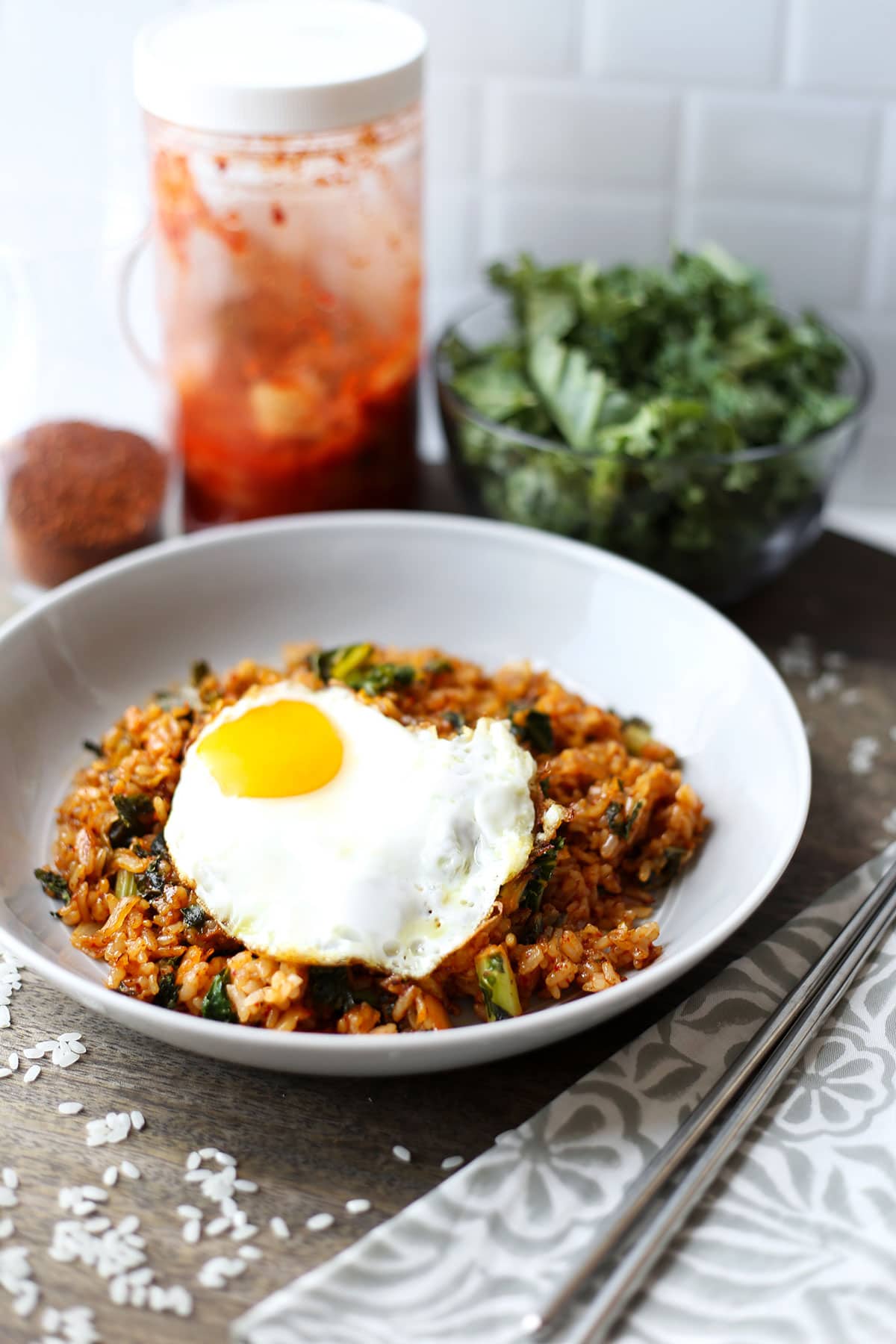
How to Make Kimchi Fried Rice
- Mise-en-place: Gather all the kitchen tools and ingredients required to make this dish.
- Pan fry the kimchi: This step gets rid of the excess liquid in the kimchi, rendering it more concentrated in flavor. Fry in a pan with a little oil for a couple of minutes.
- Cook the rice and kale: Stir in the rice and kale, cover with a lid and cook for 2-3 minutes.
- Add the remaining seasonings. Stir in the remaining ingredients (except the egg if you are using one), and cook for a couple more minutes.
- Serve: Transfer the kimchi fried rice to a plate and enjoy while it’s warm. Alternatively you can let it cool to room temperature and refrigerate it for later, in an airtight storage container.
Cooking Tips
- Use a large skillet to ensure there’s enough space to properly toss all the ingredients so the rice is evenly seasoned.
- If you would like to add a protein such as chicken or shrimp, cook it separately, in another pan, and add it to the fried rice at the same time as the spinach. This ensures that the protein is fully cooked and will stay moist and tender.
- For the perfect fried egg, add a little more oil than you normally would to fry eggs. Wait until the oil is very hot before adding the egg. You should see the outer edges of the egg fry very quickly and turn a golden brown color.
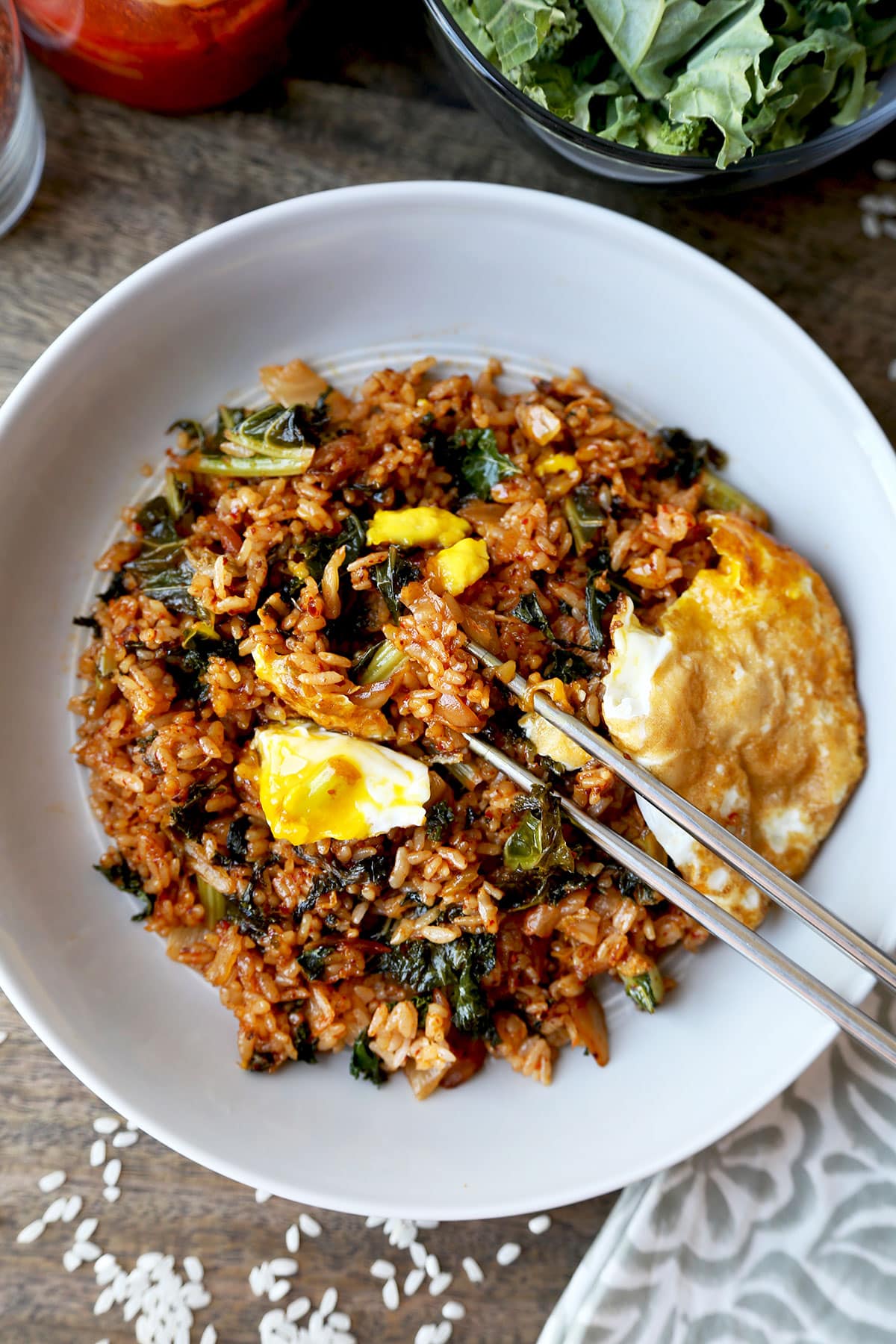
Storage
Fridge: Let the fried rice cool to room temperature and transfer it to a storage container. It will keep in the fridge for up to 5 days.
Freezer: Let the fried rice cool to room temperature. Divide the rice into individual serving sizes and save it in sealable storage bags or airtight containers. Freeze for up to 1 month.
TIP: Thaw and reheat fried rice only once to prevent bacteria from developing.
Frequently Asked Questions
Kimchi (김치) is a Korean side dish of vegetables that have been fermented in a mixture of gochugaru (Korean chili flakes), garlic, ginger, scallions, fish sauce, and sugar. There are many different types of kimchi but the most popular one is the baechu kimchi, which is mainly made up of napa cabbage. Other popular kimchi vegetables are cucumber, radish, scallions, mustard leaf, and carrots.
That depends on the kimchi you are using and if the recipe contains soy sauce. Good substitutes for soy sauce are tamari and liquid aminos. As for kimchi, it is generally gluten-free but it’s always best to check the label for gluten containing ingredients such as wheat and fish sauce. Or you can look for brands that say gluten-free, such as Choi’s Kimchi Company.
Korean fried is generally much more flavorful than other fried rices. Because it contains sour, salty, spicy, and smoky flavors, its taste is more complex, making it a unique dish in the fried rice category. The texture can also be chewier than other fried rice.
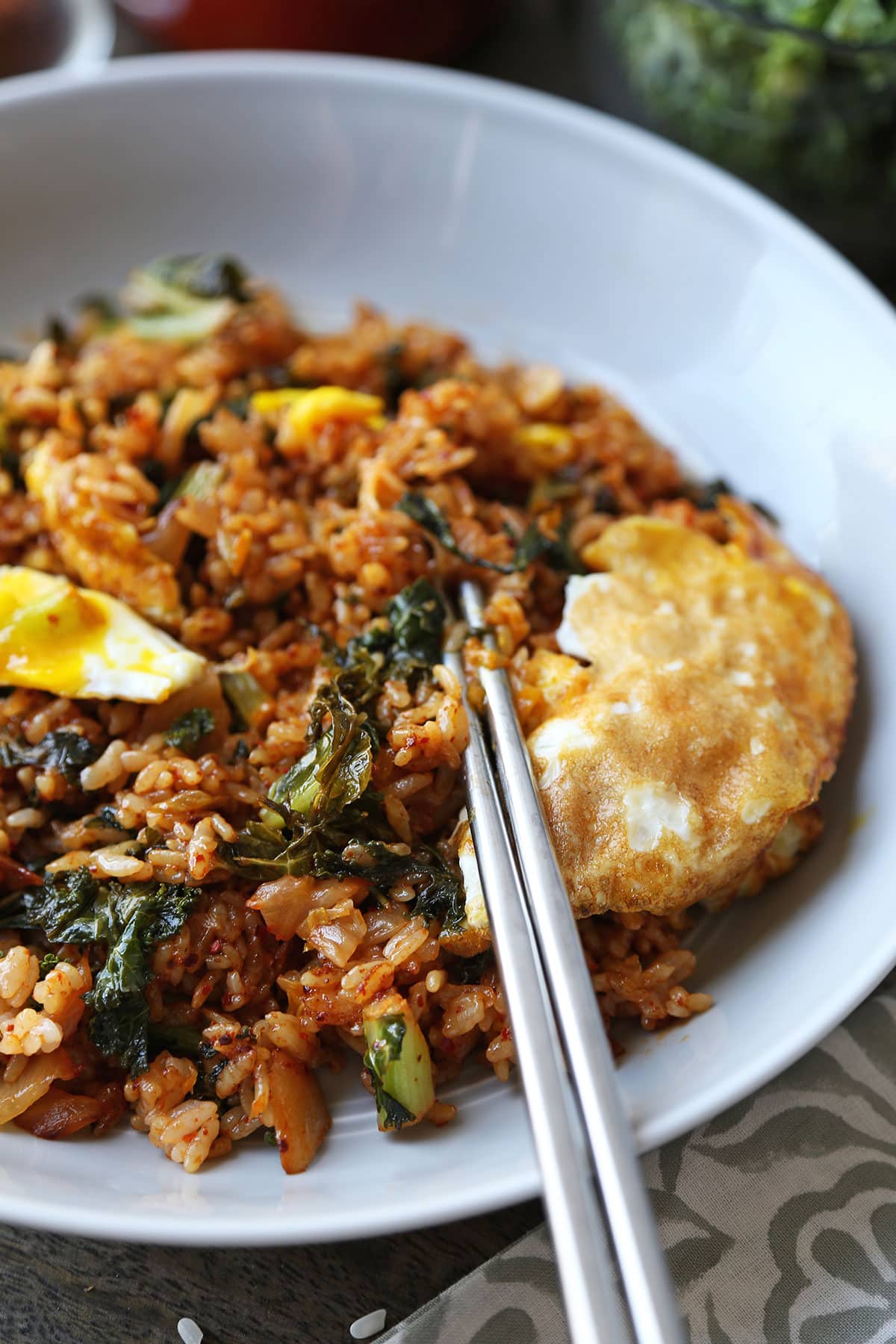
What to Serve with Kimchi Fried Rice
Stick with side dishes that don’t overwhelm the palate since the flavors of this kimchi fried rice are quite assertive.
Some of my favorites are:
- Korean chive pancakes (buchujeon)
- Korean seaweed tofu soup (tofu miyeok-guk)
- Korean bean sprout salad (sookju namul)
- Korean steamed egg (gyeran jjim)
Subscribe to my newsletter and receive the latest recipes and weekly favorites straight to your inbox. Join me on Pinterest, Facebook, and Instagram for more cooking tips and adventures!
Did you like this fried rice? Are there changes you made that you would like to share?
Print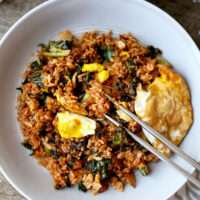
Kimchi Fried Rice – Kimchi Bokkeumbap
- Prep Time: 10 minutes
- Cook Time: 10 minutes
- Total Time: 20 minutes
- Yield: 4 1x
- Category: Rice
- Method: Stir fry
- Cuisine: Korean
- Diet: Vegetarian
Description
Kimchi fried rice (김치) is full of pungent, salty and sour flavors. It’s a classic Korean meal you can make at home in just 15 minutes!
Ingredients
- 2 tablespoons vegetable oil or grapeseed oil
- 1 cup kimchi, chopped
- 3 cups cooked day old Japanese rice
- 1/4 cup kimchi juice
- 3 1/2 tablespoons soy sauce
- 1 1/2 tablespoon rice vinegar
- 1 tablespoon Korean pepper flakes (gochugaru)
- 2 teaspoons sesame oil
- 1 cup spinach, chopped (optional)
- 4 large eggs (optional)
Instructions
- In a pan over medium high heat, add oil and when the oil is hot, add the kimchi.
- Cook for 2 to 3 minutes until the kimchi is soft.
- Add the rice and kimchi juice and break the rice apart with a paddle. Mix all of the ingredients and stir in the soy sauce, rice vinegar, and Korean pepper flakes.
- Add the spinach and cook for 2 minutes, while stir frying the rice.
- Add the sesame oil and toss well to combine.
- Turn the heat off and transfer the fried rice to serving bowls. Serve topped with a fried egg.
Notes
This kimchi fried rice recipe will keep refrigerated for up to 1 week.
Nutrition
- Serving Size: 1 serving
- Calories: 289
- Sugar: 1.5g
- Sodium: 657mg
- Fat: 10.1g
- Saturated Fat: 1.5g
- Unsaturated Fat: 2g
- Trans Fat: 0g
- Carbohydrates: 44.3g
- Fiber: 1.5g
- Protein: 5.4g
- Cholesterol: 0mg
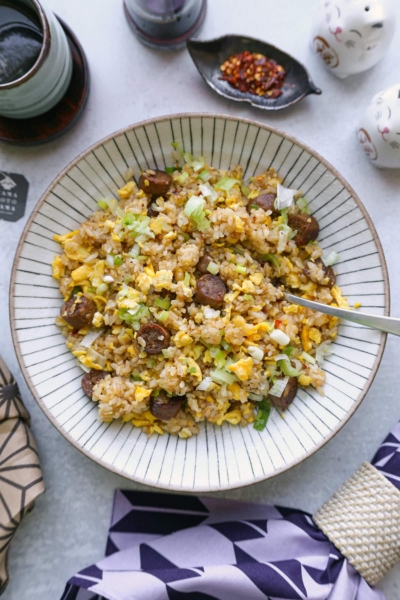
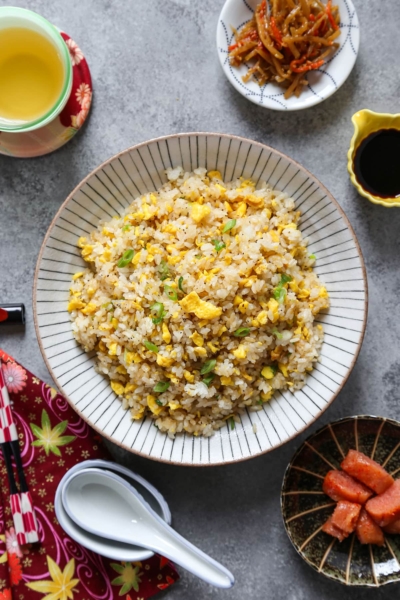
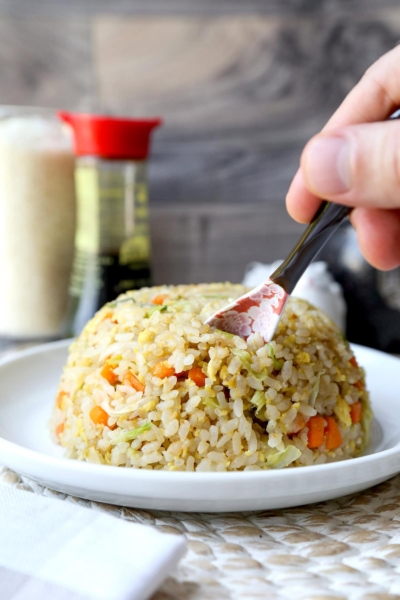
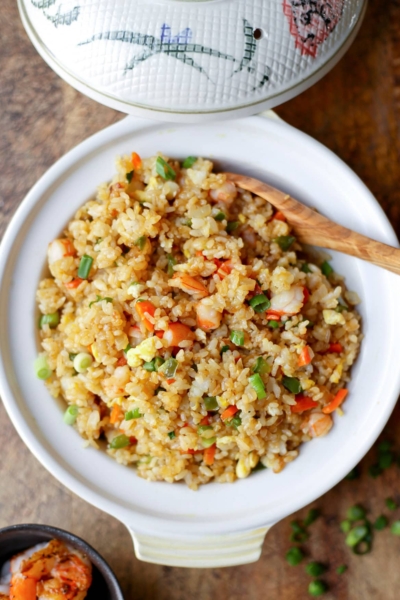















Questions and Reviews
This was very good! I made this as a one-bowl main course with a fried egg –served 2 of us. Next time I’ll cut the soy sauce as it was super salty for us, but maybe my kimchi was saltier (Cleveland classic kimchi.) I’ll also add more kale, too. I forget how much it shrinks when cooked. Excellent use of leftover rice! And perfect meal with the egg on top. Thanks!
Thank you Laurel! 🙂
Made this recipe and loved it! What brand is the hot plate you got to cook the meat? We’ve been looking for a good one.
Hi Rebecca! I use Tiger’s CQE electric skillet which comes with a hot plate and a hot pot! So you can switch between the two, I really like it and highly recommend it! 🙂
Do you use homemade Kimchi, or is this store bought, and if so, any brand or type you recommend?
I use store bought that I get in Koreatown in Manhattan, it’s called Tobagi -> http://www.seriouseats.com/2011/03/what-is-the-best-kimchi-brand-korean-cabbage.html. However there are good brands you can order on Amazon too, like this one: https://www.amazon.com/Kimchi-1-75LB-Healthy-Natural-Gluten/dp/B00AB898TK/ref=sr_1_1?s=grocery&ie=UTF8&qid=1493123595&sr=1-1-spons&keywords=kimchi&psc=1
My recommendation is to buy it at an Asian grocery store since they tend to sell bland ones at popular grocery chains.
Try squeezing the juice out of the kim-chi, adding the soy sauce to it and some fish sauce, use that in place of water after you’ve fried it up a bit – I think it makes for a deeper flavor.
Thanks for the tip Andrew!